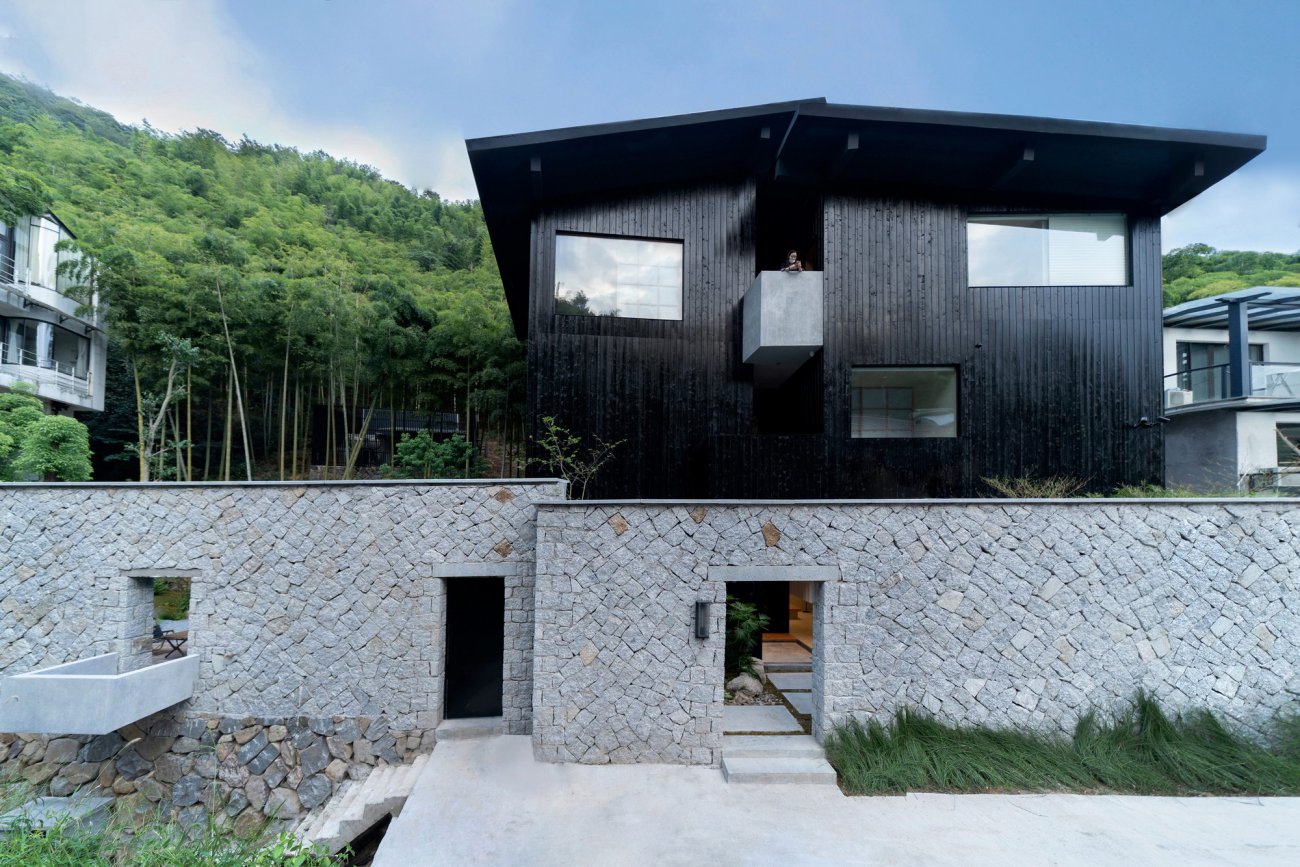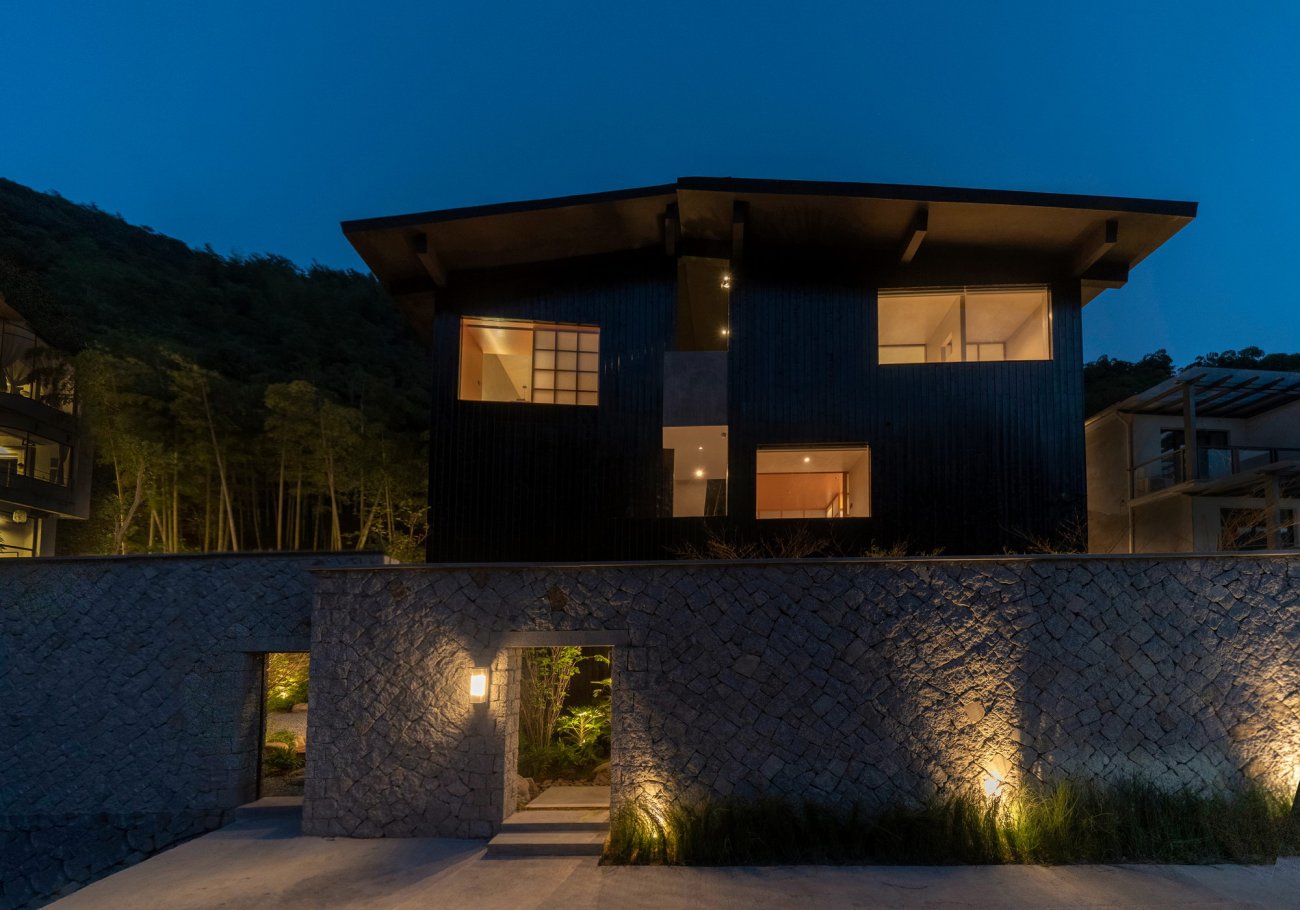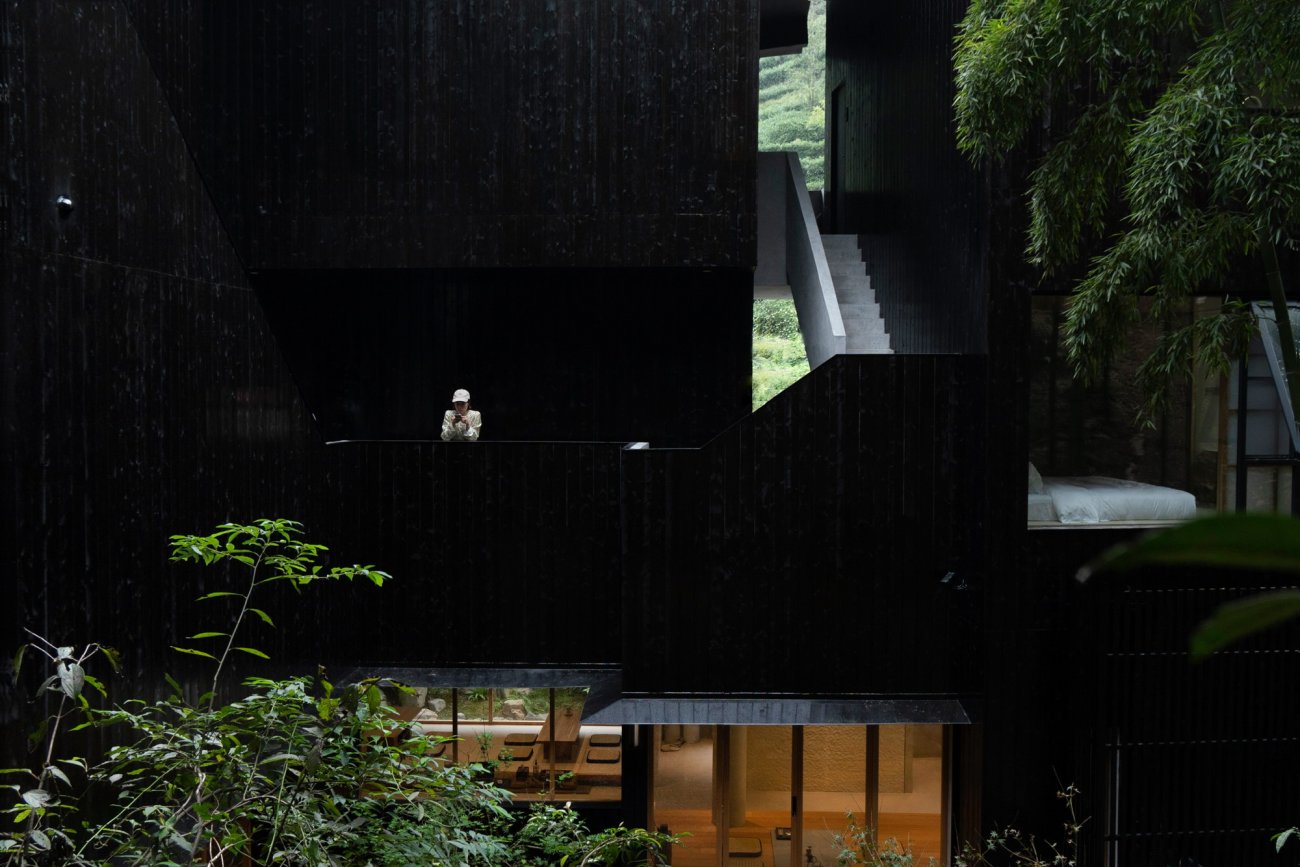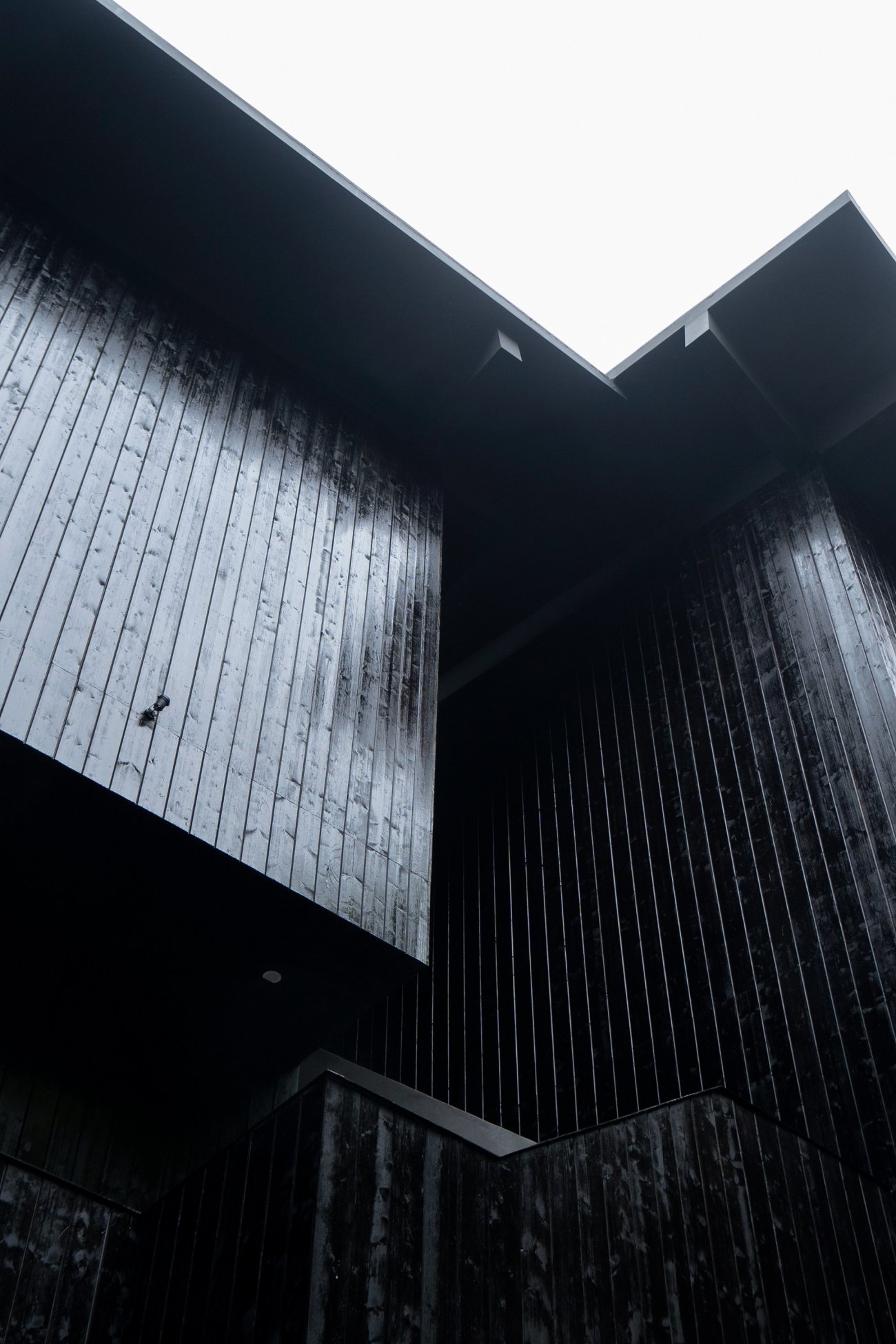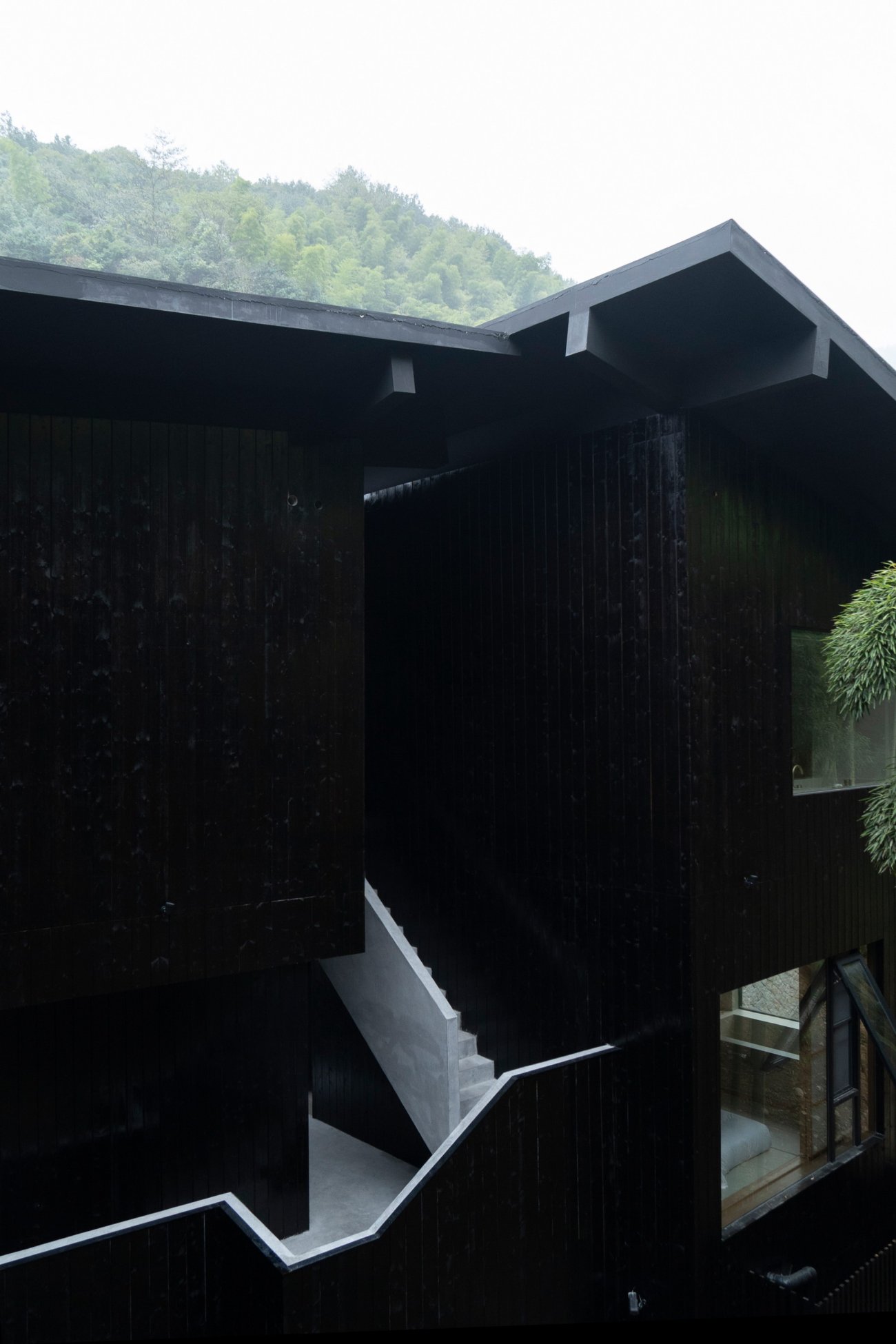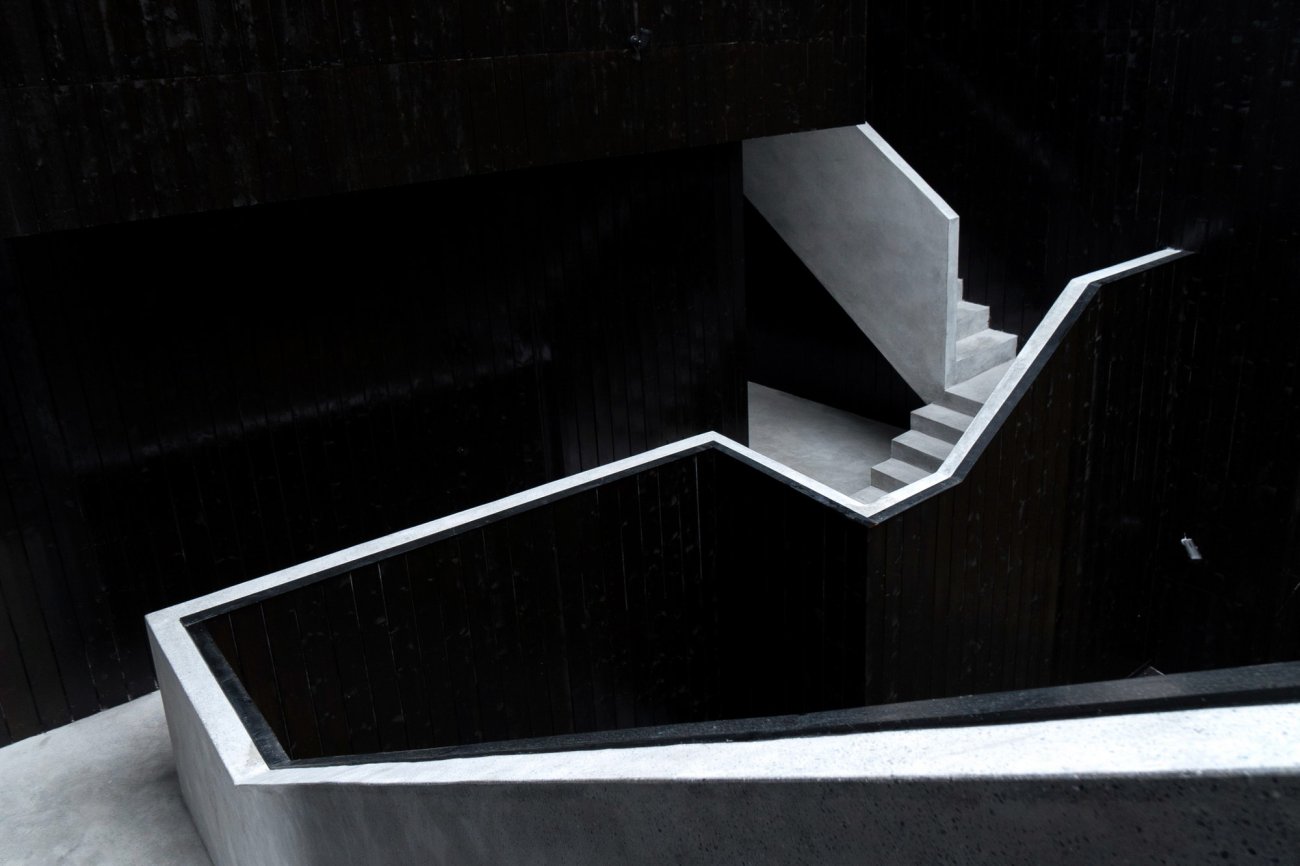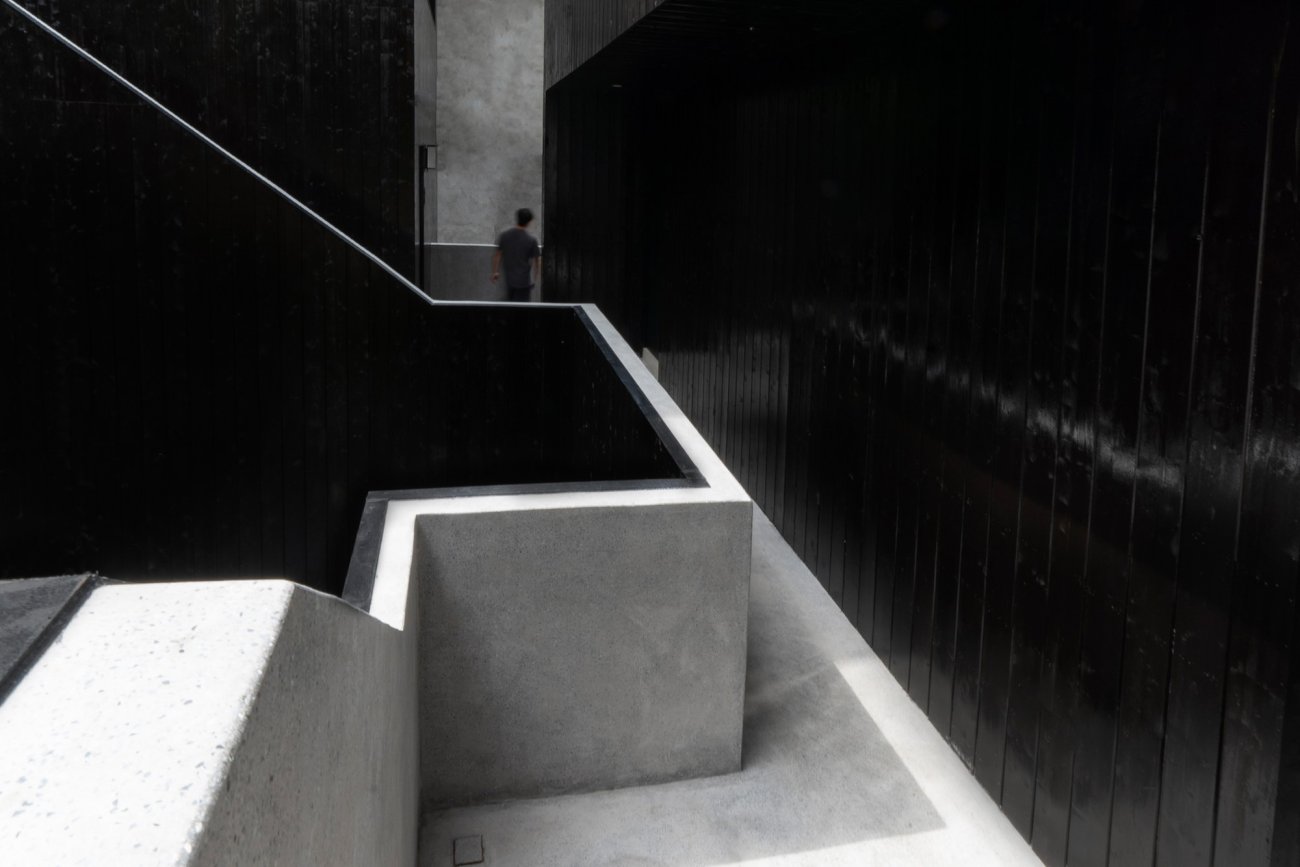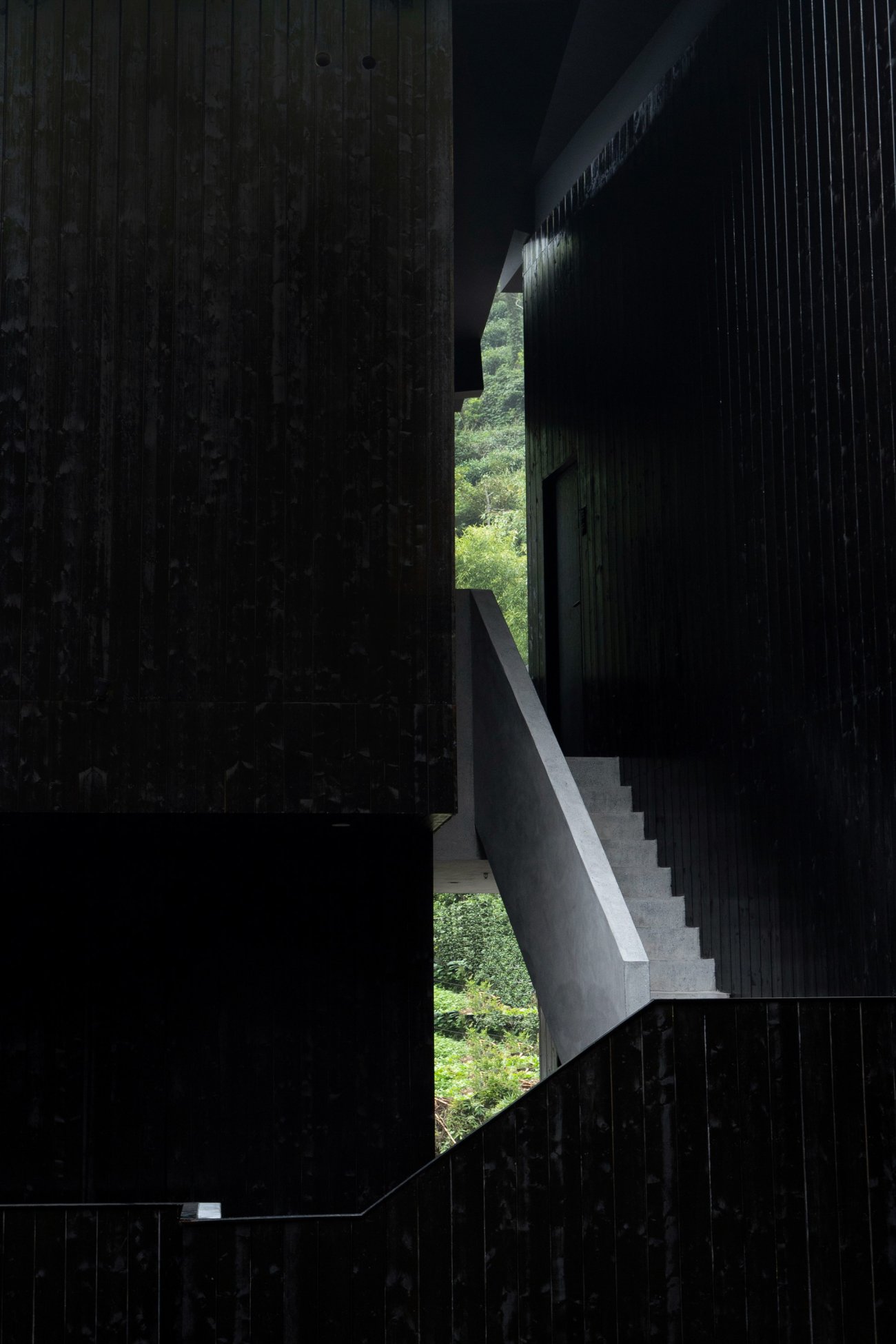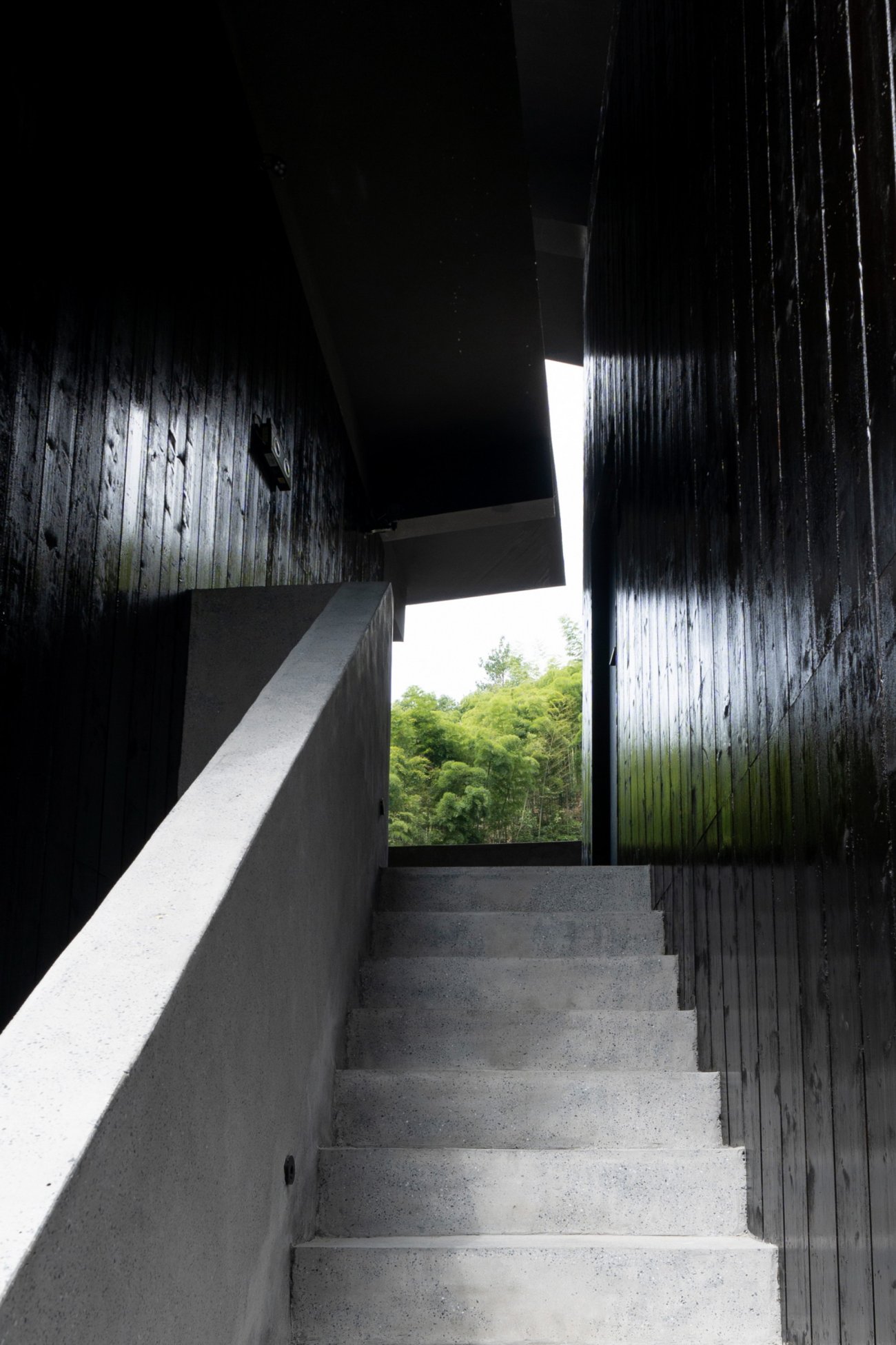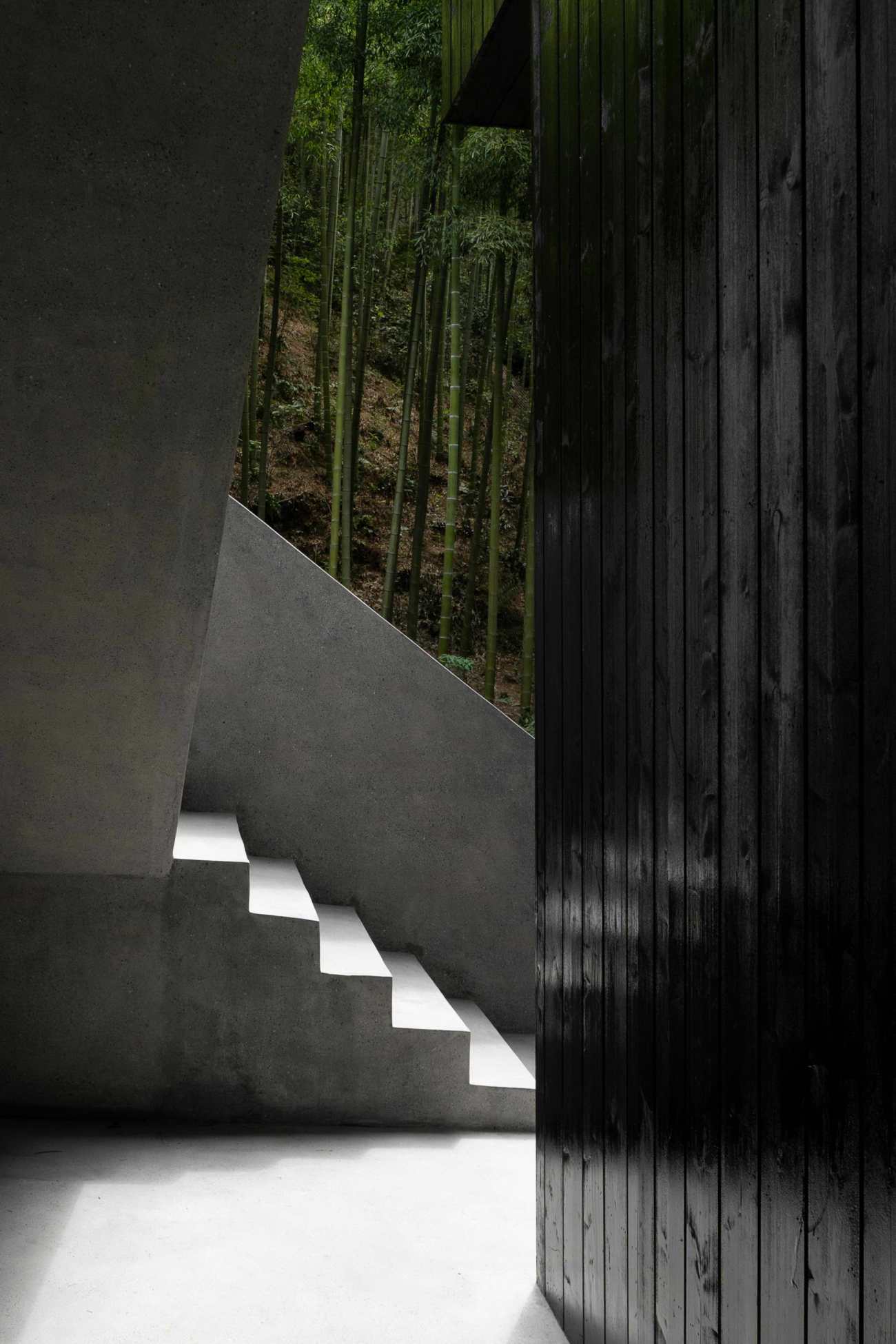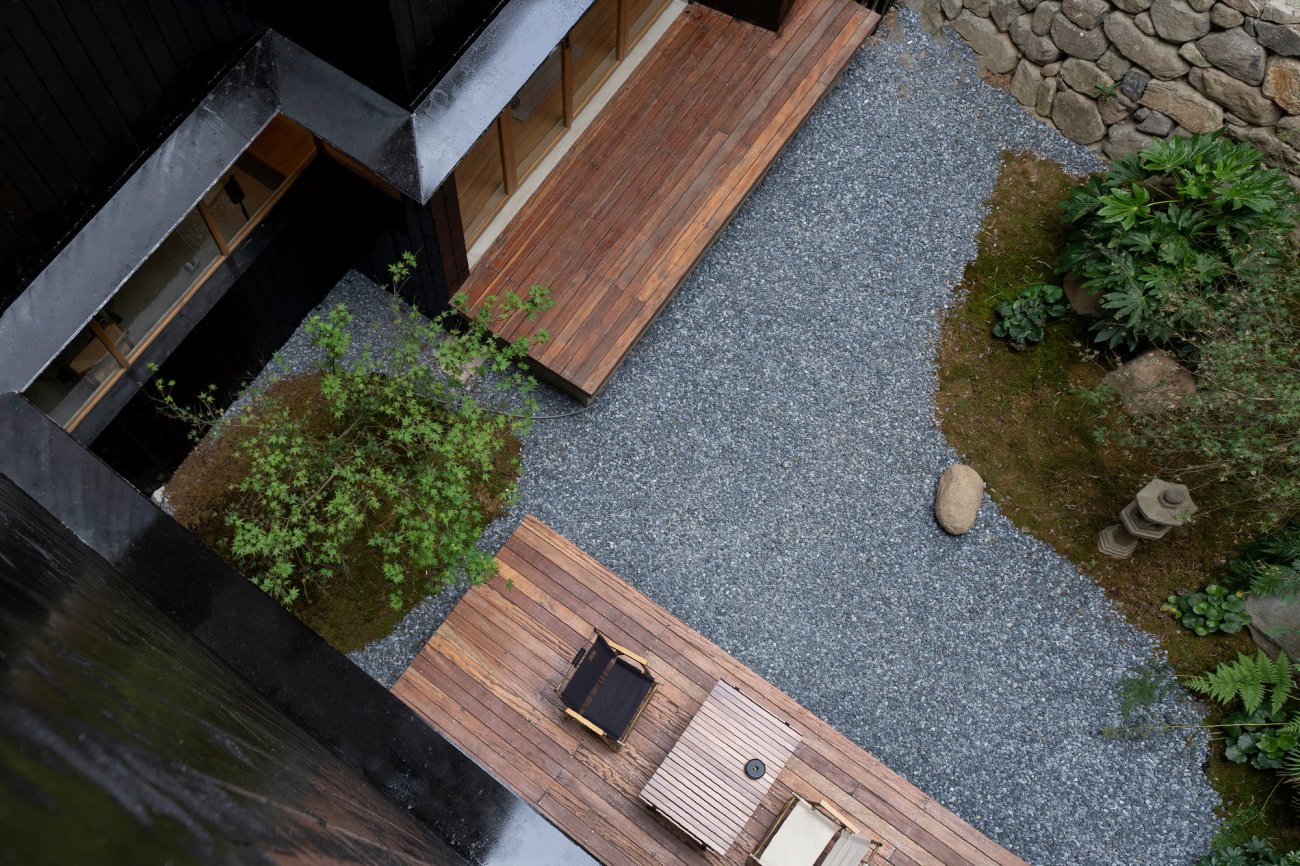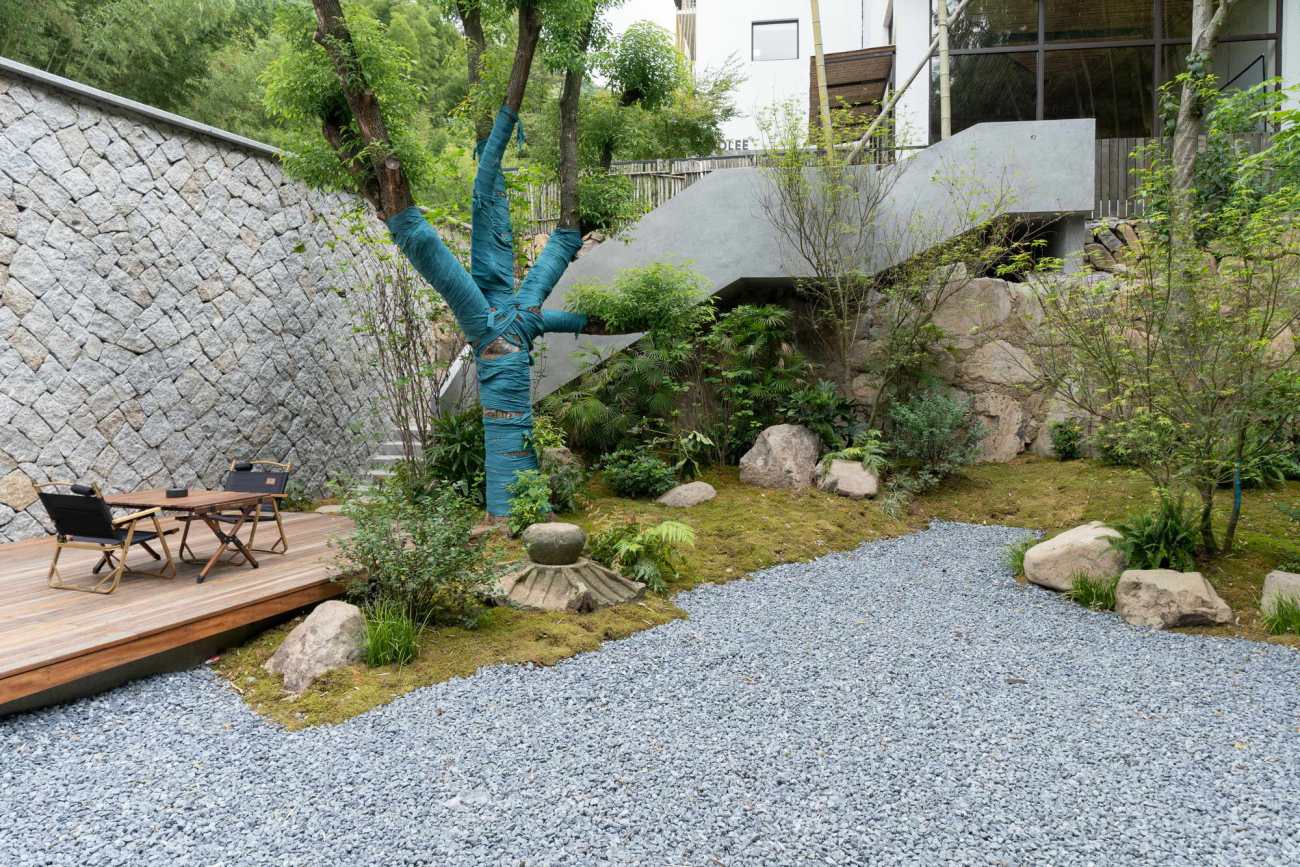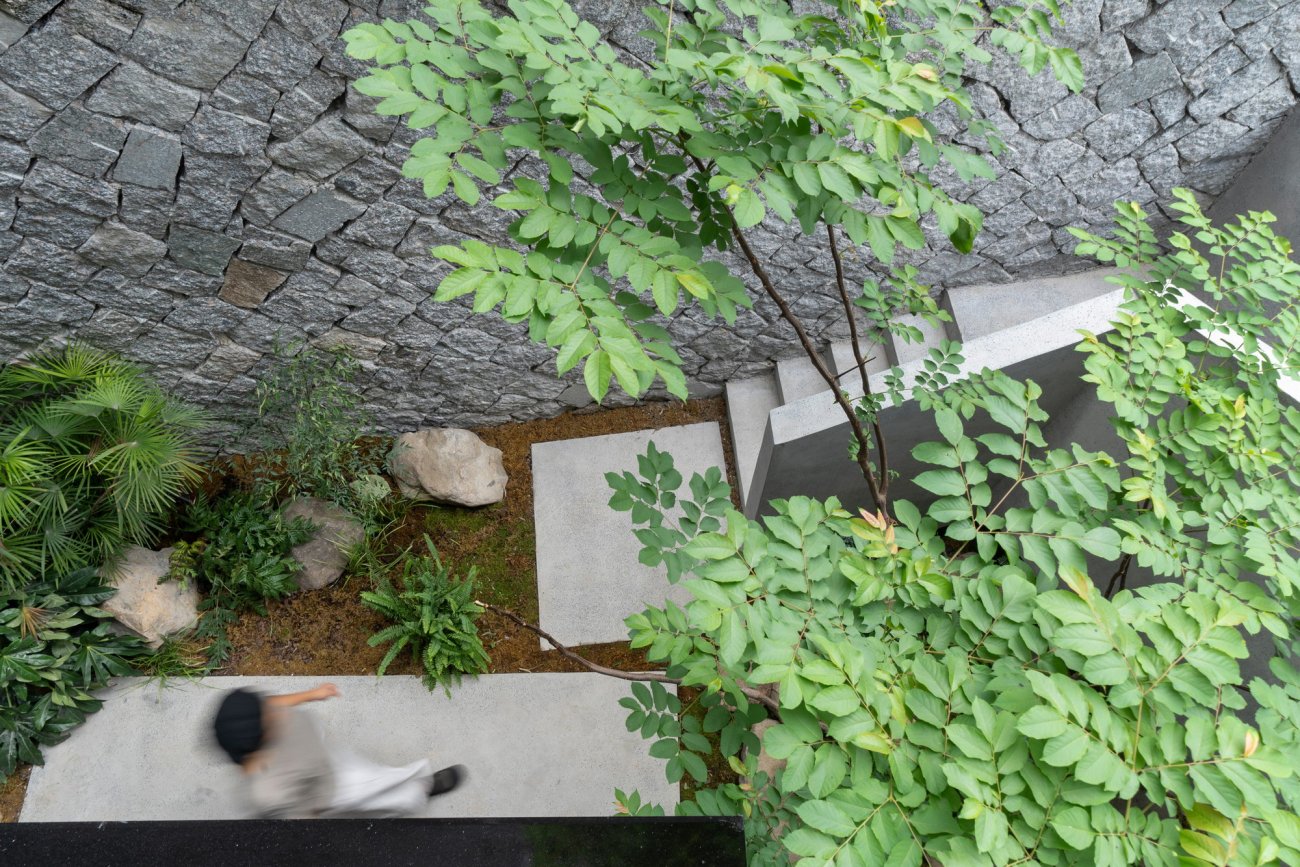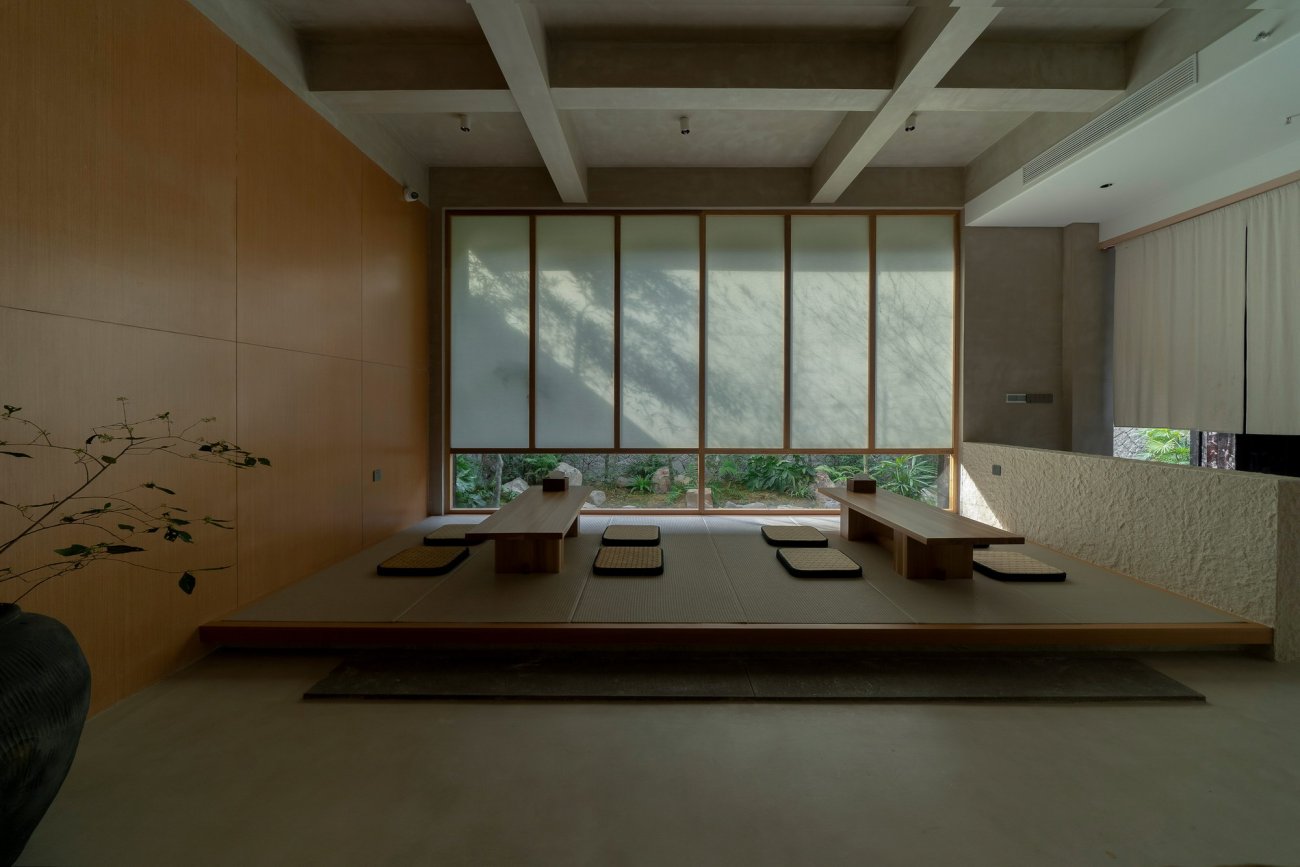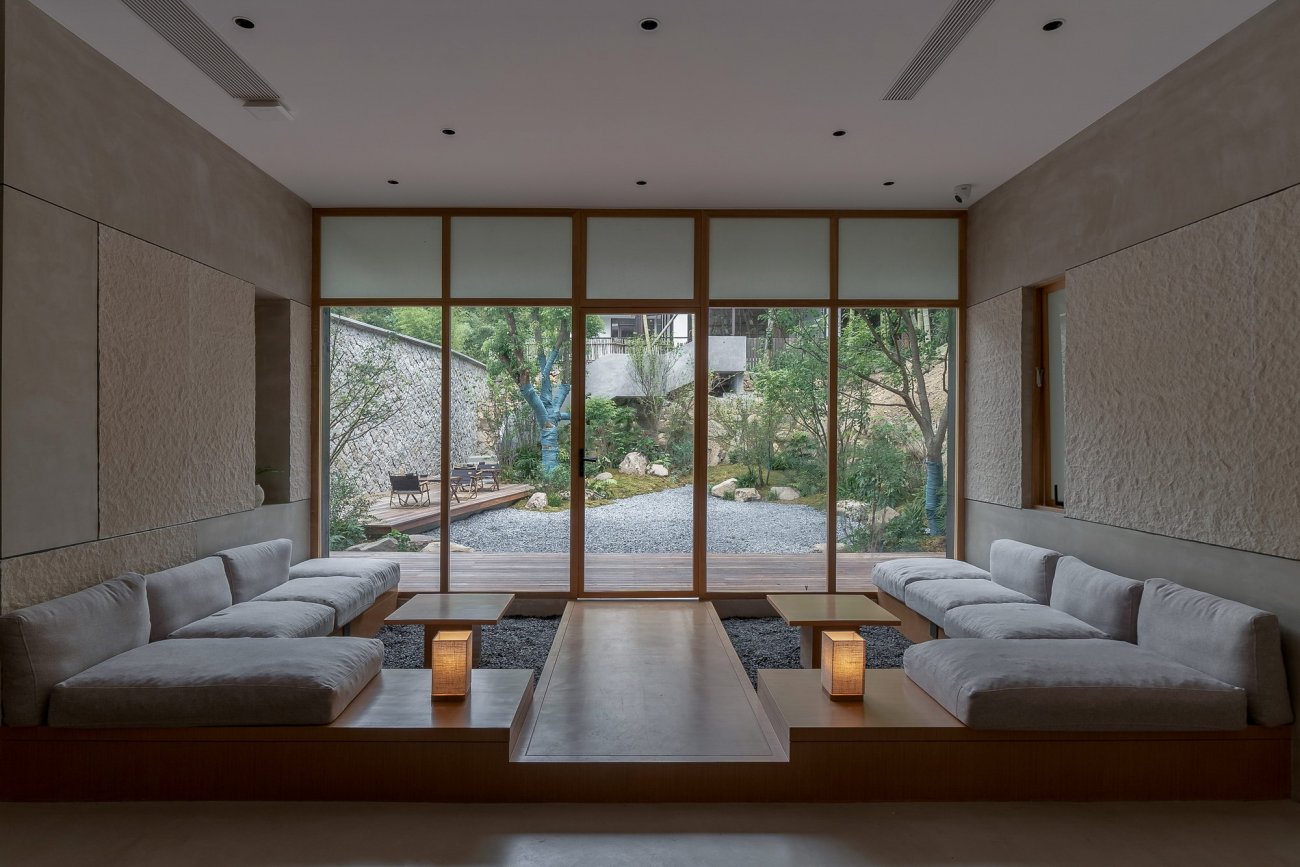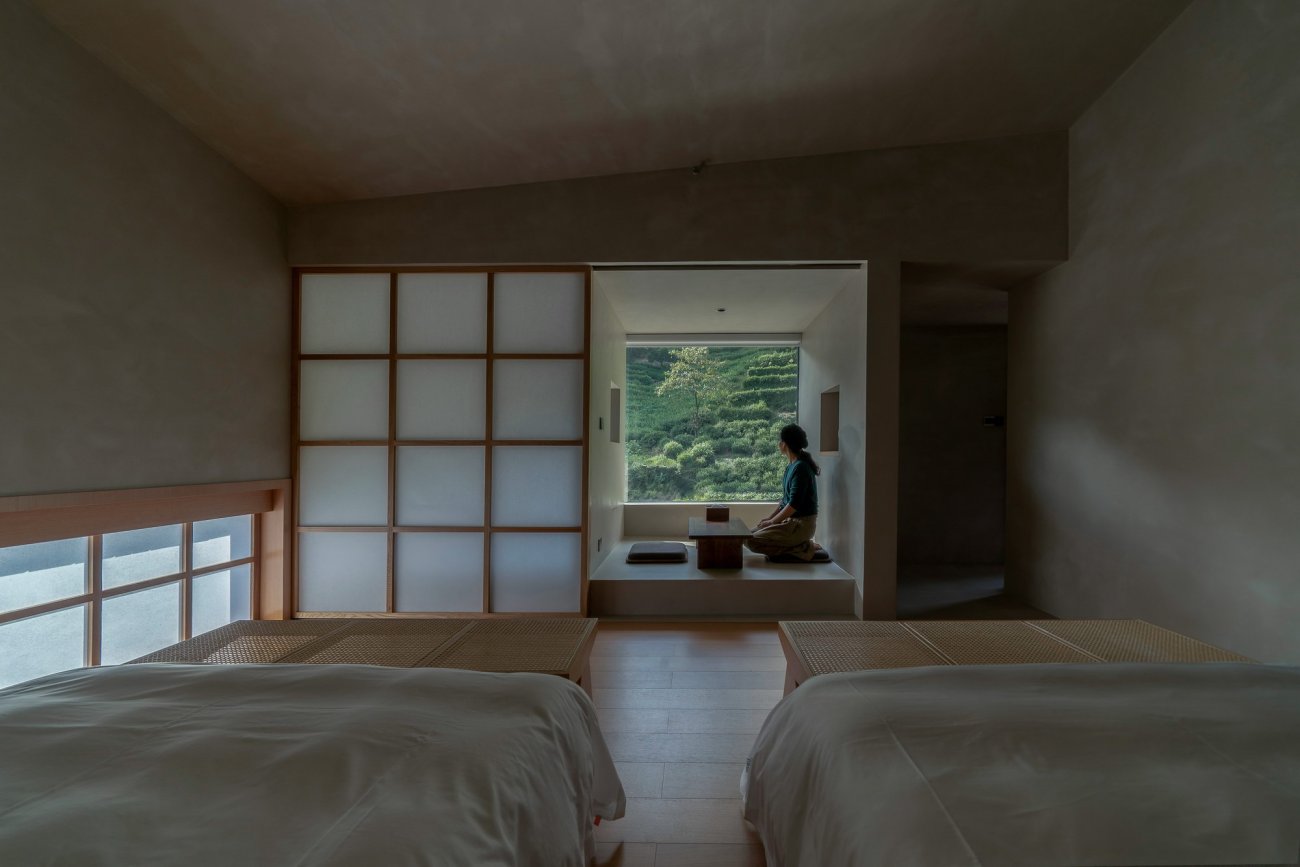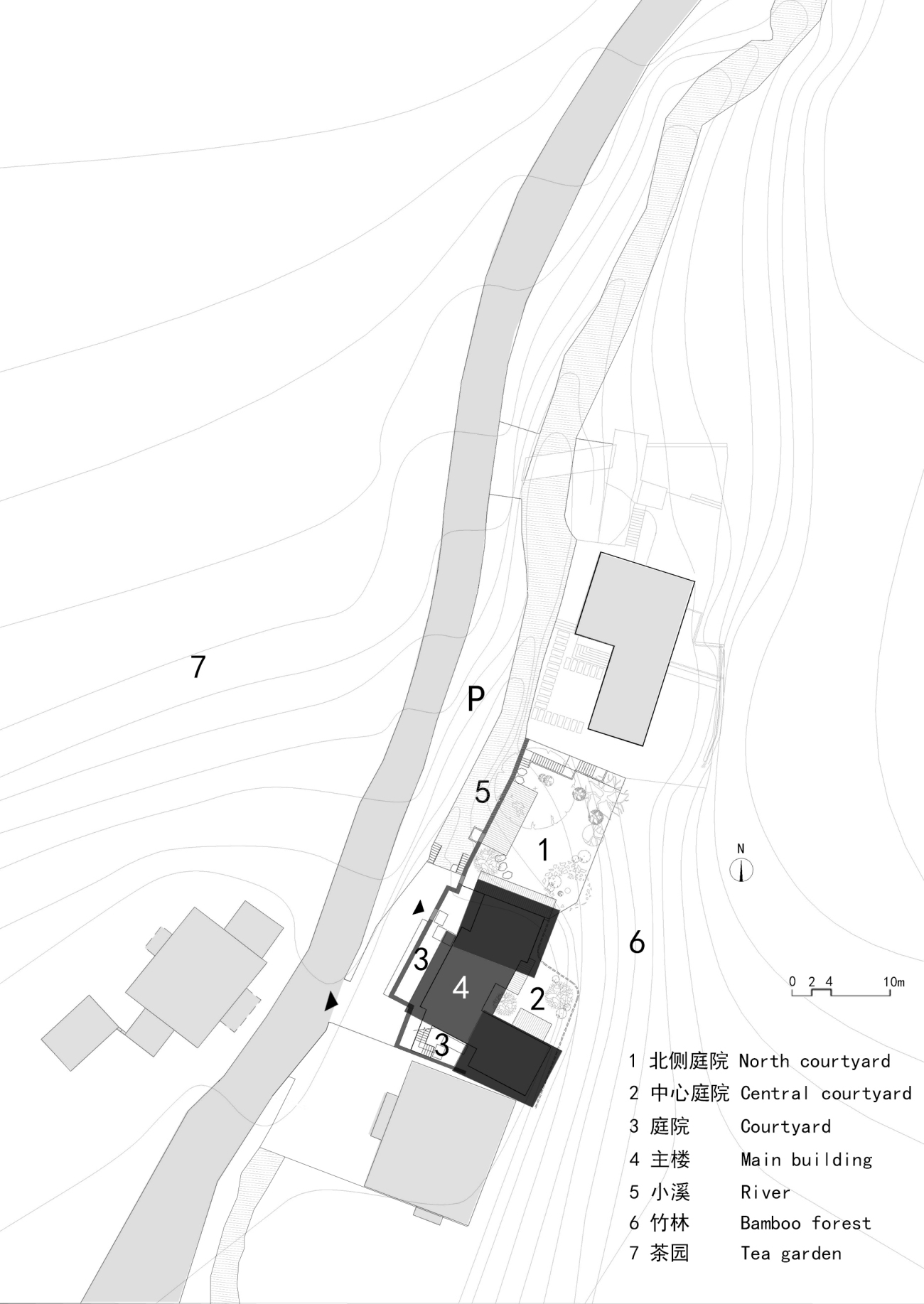| 公司: | HEI建筑设计工作室 | 类型: | 建筑 | 室内 |
|---|---|---|---|
| 地区: | 中国 | 标签: | 民宿客栈 |
概况 Overview
这是一个向内的建筑,是一个“内藏、内敛、内观”的建筑,确切地说更像是一个建筑群,一个模拟江南乡村村落结构的建筑群,也是一个现代园林建筑。
This is an inward looking building, a building "hidden, introverted and introspective". To be exact, it is more like a building group, a building group simulating the structure of rural villages in Jiangnan or a modern garden building.
▽ 所在村落布局
▽ 建筑整体在两座山体之间局促的山谷中
▽ 邻车行道、邻居多、地势低下
▽ 向内的建筑
▽ 二、三层的走廊楼梯围绕中心庭院展开
项目位于湖州市德清县莫干山镇,建成后将作为民宿功能使用,是一个新建三层建筑。北侧是民宿品牌的一期建筑,南侧紧邻一座三层民居,西侧局部临溪,小溪紧挨着一条车行干道,西南侧与场地接平,越向北道路与场地的高差越大,最北处有近4米高差。场地西南侧在路的对面还有一栋三层民居,西侧隔路是山体茶园、竹林,东侧紧邻大片竹林山体,整体在两座山体之间局促的山谷中。
The project is located in Moganshan Town, Deqing County, Huzhou City. It is a new three storey building, which will be used as a home stay after completion. The north side of the project is the Phase I building of the B&B brand, the south side is adjacent to a three story residential building, and the west side is partially close to a stream next to a main road. The southwest side of the project is linked to the site, and the higher the road goes to the north, the greater the height difference between the road and the site, with a height difference of nearly 4 meters in the northernmost part. On the southwest side of the site, there is a three storey residential building on the opposite side of the road. On the west side, there are mountain tea gardens and bamboo forests across the road. On the east side, there is a large area of bamboo forests and mountains, making the whole area in a narrow valley between the two mountains.
▽ 通过石砌围墙将一层隐藏,只露出上面两层体量
▽ 二、三层被分化成三个亲切的小体量
▽ 路上的行人看不到建筑的一层
▽ 通过石砌围墙隔绝内外
“内藏” "Hidden"
总的来说这个场地有地势低、周边建筑多、视野狭促的劣势,也有临溪、临竹林、茶园的景观优势。如何在这样的场地既能避免周边的干扰又能打造一个高品质的内部体验空间是最大的难点,我们借鉴传统园林的做法,用一座高墙隔绝内外,向内作文章,将所有空间内藏,营造一个内在的世界。
In general, this site has the disadvantages of low terrain, a large number of surrounding buildings, and narrow vision. It also has the landscape advantages of adjacent streams, bamboo forests, and tea gardens. How to create a high-quality internal experience space in such a site without surrounding interference is the biggest difficulty. Therefore, we learned from the practice of traditional gardens, used a high wall to isolate the interior and exterior, and started to hide all spaces inward to create an internal world.
▽ 北侧立面
▽ 建筑与中心庭院
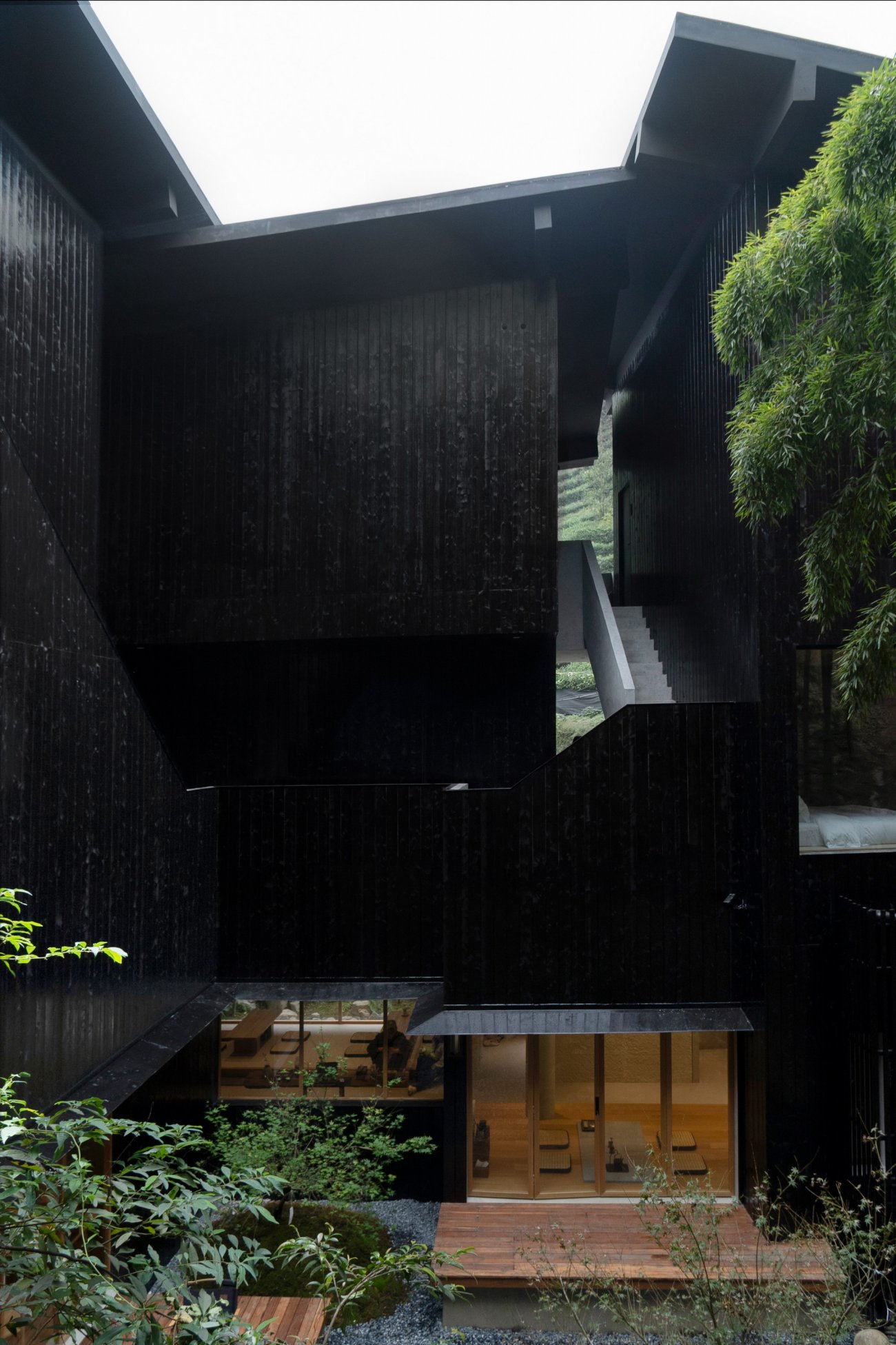 | 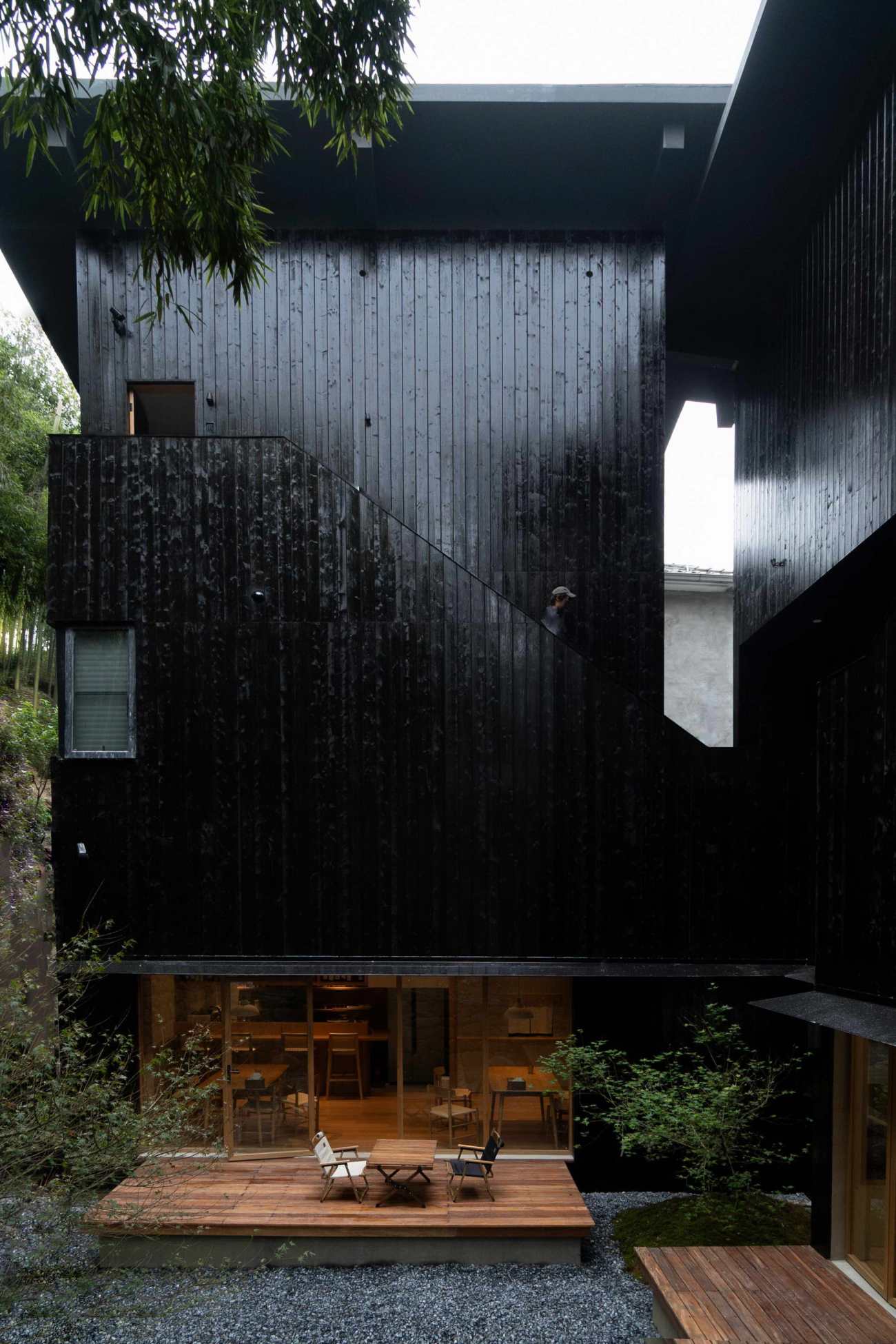 |
▽ 北侧庭院
高近四米的石砌围墙隔绝了项目内外,从入口和小溪上的悬挑露台可以看到内院的局部,几棵大树从石墙顶部露出,高墙保证了马路上的行人基本看不到院子和一层,这反而让人生起好奇心和探索欲。石墙同时也起到减少内外噪音相互干扰的作用。
The stone wall with a height of nearly four meters separates the interior and exterior of the project. Part of the inner courtyard can be seen from the overhanging terrace on the entrance and creek. Several big trees emerged from the top of the stone wall. The high wall ensures that pedestrians on the road can hardly see the courtyard and the first floor, making people curious and eager to explore. At the same time, the stone wall also plays a role in reducing the mutual interference of internal and external noise.
▽ 夜景
▽ 中心庭院夜景
▽ 北侧庭院望向大厅
▽ 二、三层交通流线围绕中心庭院展开
“内敛” "Introverted"
虽然这是一栋有着占地140、三层指标的新建建筑,我们不希望他呈现出来的是现在农村到处可见三、四层比例失衡的新建民居,希望他呈现的是更加亲切和优雅的尺度,设计将一层隐藏,二、三层被分化成三个小体量,像是三个两层的小房子,比例上是让人感觉亲切舒适的,这是尺度上的内敛。
Although this is a newly-built building with an area of 140 and three floors, we do not want it to be presented in a more intimate and elegant way in the form of three - and four floor unbalanced newly-built residential buildings that are ubiquitous in today's rural areas, but rather in a more cordial and elegant scale. The design makes the first floor hidden, and the second and third floors are divided into three small volumes, like three two-story houses. In proportion, it makes people feel friendly and comfortable, reflecting the introversion of the scale.
▽ 外挑屋檐
▽ 客房不朝向中心庭院开窗、避免相互干扰
▽ 建筑与后山竹林
▽ 二、三层的转折步道
我们不希望它是一个“外来物”,希望它能很好地融入乡村的土地,能够唤起人们对传统江南民居的记忆。青骊的“骊”在古代就是纯黑的意思,我们在外墙上加了一层刷黑的防腐木板作为装饰,会让人联想起传统的浙江山地民居风化的木制外立面,加上灰色的石砌围墙共同呈现暗色调的整体外观,稳重的气质让人感觉它深深地扎在土里,存在了许久,这是外观上的内敛。
We do not want it to be a "foreign object", but to be well integrated into the rural land to arouse people's memories of traditional Jiangnan dwellings. The "Li" of Qing Li implies pure black in ancient times. We added a layer of black painted anti-corrosion wood on the exterior wall as decoration, which can remind people of the weathered wooden facade of traditional Zhejiang mountain dwellings. Moreover, the grey stone wall presents a dark overall appearance. This steady temperament leaves a feeling of being deeply rooted in the soil for a long time, which reflects the introverted appearance.
▽ 走廊与外挑屋檐
▽ 两个建筑体块之间的灰空间
▽ 外挑屋檐
▽ 屋檐下的户外走廊
▽ 户外走廊
“内观” "Introspective"
由于场地有诸多方面的劣势,我们用石砌围墙隔绝内外,将景观向内引,引向内庭院和后山的竹林,这是一个景观向内的建筑。我们打造了四个大小不一的庭院,整个建筑是完全被庭院空间包裹的,所有的室内公共空间和步道流线都是为了和庭院互动而组织。西侧庭院是从外部进入建筑的一个过度庭院,是序曲,呈长条形,也是一层榻榻米区的主要景观面;北侧的庭院尺度最大,需要满足一、二期共同在户外组织活动的尺度,是相对舒展和放松的;南侧庭院尺度最小,结合户外楼梯布局;东侧由建筑和山体围合出了一个内庭院,是整个项目的中心庭院,异化于传统民居的天井。一层做了L型一长条的开窗面朝向这个院子,从茶台和居酒屋也都可开门进入这个院子的木平台。二、三层的走廊楼梯也围绕这个中心庭院展开,是对这个中心庭院的二次朝拜,这种手法也同传统民居二层围绕天井布置的内廊相似。从一层到三层对中心庭院的反复围观更增强了这个建筑的“内观性”。
Because the site has many disadvantages, we used stone walls to isolate the interior and exterior to lead the landscape inward to the inner courtyard and the bamboo forest in the back mountain. This is a landscape inward building. We built four courtyards of different sizes, so that the whole building could completely enclosed by the courtyard space. All indoor public spaces and footpath streamline were designed to interact with the courtyard. The west courtyard is a transitional courtyard that enters the building from the outside, which is the prelude. It is a long strip, which is the main landscape of the tatami area on the first floor; The courtyard on the north side has the largest scale and needs to provide space for outdoor activities in Phase I and Phase II, which is relatively relaxing; The courtyard on the south side has the smallest scale, which is arranged in combination with outdoor stairs; The east side is surrounded by buildings and mountains to form an inner courtyard, which is the central courtyard of the whole project, different from the courtyard of traditional dwellings. On the first floor, an L-shaped window with a long strip was designed to face the courtyard. The wooden patio is accessible from the tea table and wine house doors. The corridor stairs on the second and third floors also surround the central courtyard, which is the second worship of the central courtyard. This technique is similar to the inner corridor arranged around the courtyard on the second floor of traditional residential buildings. The repeated observation of the central courtyard from the first floor to the third floor further enhances the "introspection" of the building.
▽ 客房之间的灰空间以及对景观的框景
客房的开窗面除了局部几个朝向西侧的茶园,几乎都朝向后山的竹林,这也是“向内观”。因为二、三层的主要交通流线围绕中心庭院展开,所以客房几乎没有朝向中心庭院开窗,这样可以尽量避免视线和噪音的相互干扰,能最大限度保证客房的私密性和体验感。
Except for several tea gardens facing the west, the windows of the guest rooms almost all face the bamboo forest behind the mountain, which also reflects "introspection". Because the main traffic flow lines on the second and third floors revolve around the central courtyard, the guest rooms rarely open windows towards the central courtyard, which can avoid mutual interference between vision and noise as far as possible, and ensure the privacy and experience of the guest rooms to the maximum extent.
▽ 入口处的西侧庭院
▽ 西侧庭院望向玄关
▽ 长条形的西侧庭院
▽ 玄关望向人口处
“模拟村落 ” "Simulated village"
整个建筑的一层是一个整体,作为民宿的公共空间使用,U字型平面,保证不同功能区间相互联系又独立,二、三层作为客房空间分成了三个体块,三个小房子互不干扰,保证每个客房间的噪音干扰降到最低。三层的外挑屋檐相互交错创造出了许多灰空间,使得每个客房门口都有自己的半户外休憩空间,也同时对竹林和远山做了框景。西侧的体块为了视线上避开西南侧的邻居,同时更好的朝向对面的茶园,在体块上做了一个角度上的偏转,这也让整个建筑变得更加活泼丰富。
The first floor of the whole building is a whole, which can be used as the public space of home stay. It is a U-shaped plane to ensure the mutual connection and independence of different functional areas. The second and third floors of the building are divided into three individual blocks as guest rooms. The three small houses do not interfere with each other to ensure that the noise interference in each guest room is minimized. The overhanging eaves on the third floor are interlaced to create a lot of gray space, making each guestroom doorway form an independent semi outdoor rest space. At the same time, the frame scenery of bamboo forests and distant mountains was designed. The block on the west side was designed to avoid the neighbors on the southwest side and better face the opposite tea garden. On the block, an angle deflection was designed to make the whole building more lively and rich.
▽ 中心庭院
▽ 茶台望向中心庭院
三个小房子也是对传统村落的一个模拟,走进这个建筑就像走进一个村落,是一个有趣、自然的建筑群落。走廊、楼梯就像是山村里中交错的巷道和石阶,是村落里暧昧的灰空间。在你从一层公共空间走到自己房间的过程中已经不自觉地完成了和自然的交流互动。
The three small houses simulate a traditional village. When you walk into this building, you will feel like walking into a village, and you will find it is an interesting and natural architectural community. Corridors and staircases are like interlaced lanes and stone steps in a mountain village, which are ambiguous grey spaces in the village. In the process of walking from the first floor public space to your own room, you have unconsciously completed the communication and interaction with nature.
▽ 北侧庭院
▽ 北侧庭院的木平台
“转折” "Transition"
那园林如何建构和模拟一个自然世界,自然的本质是变化,而转折是变化的最基本单元,庭院步道的转折、建筑体块的转折、竖向交通的转折共同建构出一个流动、变化的复杂空间体验。二维到三维的转折,将整个建筑的室内外流线传串连折叠起来,有点像是园林里攀爬假山的体验,复杂交错的流线极富趣味。转折首先是线性的,所以它是一个整体,但它又是流动的、错位的,所以在两侧布置的空间既相互关联又相互区隔。
How do gardens construct and simulate a natural world? The essence of nature is change, and transition is the most basic unit of change. The transition of courtyard footpath, building block and vertical traffic together make a complex space experience of flow and change constructed. The transition from 2D to 3D makes the indoor and outdoor streamline of the whole building folded, bringing people the experience of climbing rockery in the garden and the interest of complex and interlaced streamline. First of all, the transition is linear, so it is a whole. However, the transition is flowing and dislocated. Therefore, the spaces arranged on both sides are both related and separated from each other.
▽ 南侧庭院
整个建筑体块是一个三维的转折流线,户外楼梯、走廊从平面到竖向做了很多转折的串联,使得在建筑中游走产生了许多变化的视野和景观,增加了整个建筑的趣味性。
The whole building block presents a three-dimensional turning streamline shape. From the plane to the vertical, the outdoor stairs and corridors are connected in series with many transitions to create a lot of different views and landscapes in the building, thus increasing the interest of the whole building.
▽ 茶台、吧台、居酒屋长条开窗面向中心庭院
▽ 榻榻米区对西侧庭院的框景
▽ 面向北侧庭院的框景
▽ 南、北体块朝向后山竹林的景观面
▽ 西侧体块偏转后正对茶园景观
“石材与木材” "Stone and Wood"
为了让整个建筑更好地融入乡村环境,我们选用石材和木材这种自然材料作为外立面的主要基材,围墙用毛石现场手工破凿,整体厚重沉稳,像是整个建筑的基座,墙上的开口,作为入口和与小溪互动的露台,打破大面积石墙的单调。外立面用刷黑的防腐木做装饰,木材的肌理让整个建筑温润亲切却也现代简约。
In order to better integrate the whole building into the rural environment, we chose natural materials, including stone and wood, as the main base materials of the facade. The rubble cut by hand on the site is used to build the wall to make the whole building thick and stable to form the base of the whole building. The openings on the wall were used as entrances and terraces to interact with streams, breaking the monotony of large stone walls. The facade was decorated with black painted anti-corrosion wood. The texture of wood can not only make the whole building warm and friendly, but also highlight the modern simple style.
▽ 毛石手工砌筑石围墙
▽ 木制装饰立面
庭院也用了很多当地自然的卵石打造,包括庭院与后山竹林边界的石坎墙以及庭院地面的铺陈,中心庭院和北侧庭院的石坎用了两种大小的石头和铺砌手法,为了凸显中心庭院的特殊性,用小卵石人工铺砌,当地石匠叫“排皮”砌法,最后呈现出精致的横向肌理。北侧庭院朝后山竹林和一期的两处石坎墙使用大型卵石用挖机排砌,缝再用泥浆填充,显得粗野而自然。
The courtyard was made of many local natural pebbles, including the stone ridge wall at the boundary between the courtyard and the back bamboo forest and the pavement of the courtyard ground. The stone ridge of the central courtyard and the north courtyard used two sizes of stones and paving techniques to highlight the particularity of the central courtyard. In addition, the method of manual paving with small pebbles is called "row skin" masonry by local masons, which finally presents exquisite horizontal texture. Large pebbles were used in the bamboo forest facing back in the north courtyard and the two stone ridge walls in Phase I, and the excavator was used for laying. The gap was filled with mud, reflecting its rudeness and nature.
▽ 设计图纸
项目名称:青骊民宿
建筑设计:HEI建筑设计工作室(HEI Architectural Design Studio)
建筑设计主创:彭贤飞
室内设计:陈俊宇、笪文博
植物配置:吕文江
建筑施工图:柳军
结构:陈亚雄
装饰施工单位:德清星成装饰有限公司
项目地址:浙江,德清,莫干山镇
建筑面积:382 m2
视频拍摄、剪辑:uhe Studio
照片摄影:Alili、uhe Studio
Project name: Qingli Home stay
Architectural design: HEI Architectural Design Studio
Chief architect: Xianfei Peng
Interior design: Junyu Chen, Wenbo Da
Plant configuration: Wenjiang Lv
Construction drawing: Jun Liu
Structure:Yaxiong Chen
Decoration construction unit: Deqing Xingcheng Decoration Co., Ltd
Project address: Moganshan Town, Deqing, Zhejiang
Building area: 382 m2
Video capture and editing: uhe Studio
Photograph:Alili、uhe Studio
更新日期:2022-11-09 10:51:38
非常感谢 HEI建筑设计工作室 带来的精彩项目, 查阅更多Appreciations towards HEI Architectural Design Studio for sharing wonderful work on hhlloo. Click to see more works!






